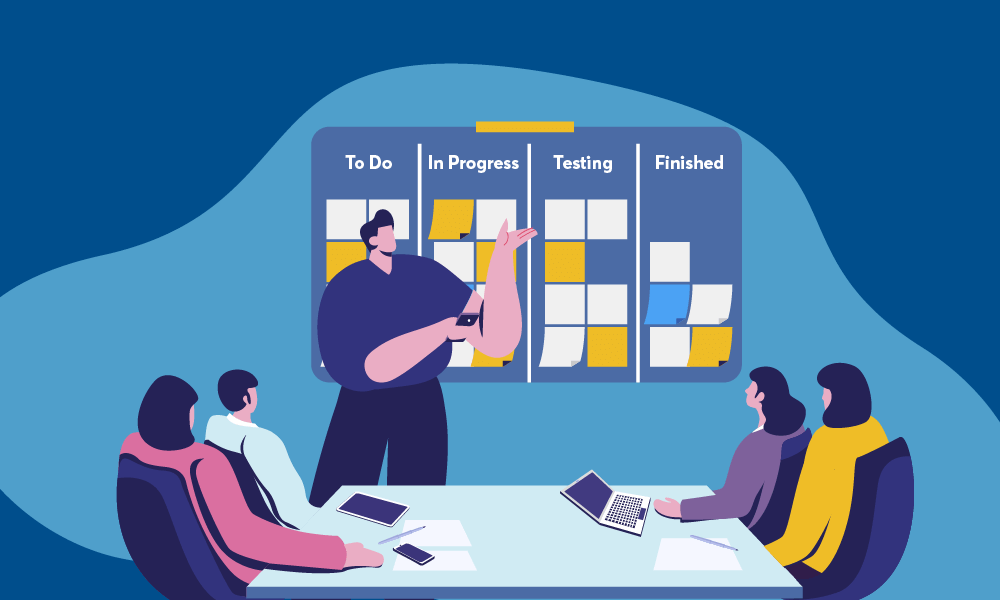If you’re like most project managers or Scrum masters, you’ve probably found that daily stand-ups can be a helpful way to keep your team on track. You likely have set a meeting on your team’s calendar for 30 minutes to get together each day and talk about what’s going on.
It probably worked for a while, with you facilitating each session, but then it starts to fall apart. People start going on and on and sharing information that’s not relevant, taking up significant time, and the value of the meeting is diminished to the point where people stop attending consistently.
You can do better. Your team needs an effective sync. We’re going to fix this.
You might think, “Oh, daily stand-ups, that’s just a Scrum thing, right?” Wrong. Daily stand-ups can help any team stay aligned and move forward together.
Daily stand-ups are a staple of many project management and development processes, but they can often be ineffective and unproductive. Personally, I have a decade of experience navigating and facilitating numerous projects and teams, each with their own way of conducting stand-ups, syncs, and scrums.
I’m classically trained in both Agile and predictive project management methodologies, making me well-equipped to tackle this often contentious topic.
In this blog post, I’ll explore how to run an effective daily stand-up meeting and get the most out of this important process. I’ll also cover tips on agenda items, timing, and how to handle distractions during the meeting as project managers.
First, What Is A Daily Stand-Up?
A daily stand-up is a meeting that occurs every day to help ensure that everyone is on the same page and knows what they need to do. It usually lasts around 10-15 minutes, and everyone in the project or Scrum team participates.
The goal as project managers of a daily stand-up is to get everyone on the same page, celebrate incremental progress, and help identify any potential roadblocks such that they can be resolved swiftly. Daily stand-ups are not only for agile teams or software development teams—they are for everyone!
In typical daily stand-ups, the team gathers together to each answer three short questions, (this is the stand-up meeting agenda):
- What did you do yesterday?
- What are you going to do today?
- What is blocking you from making progress?
As each member answers the three questions, any collaboration or opportunities to unblock members are noted for discussion after all members have shared.
Someone sharing a blocker might get a follow-up response from another member: “let’s talk; I think I can help you fix that.” This spurs a further discussion after the stand-up has met its primary objective.
In a best-case scenario, the members will meet briefly just after the stand-up to handle whatever it is that is blocking progress so everyone can go about their day and be as effective as possible.
Ta-da! That’s it! A daily stand-up is simple to learn, but tough to master with a team because teams are always changing, new issues arise, and working styles evolve. Don’t worry! We’ve got that covered too. Read on!
What should I call the session?
There are many names for this highly-effective meeting. Most often, I hear daily stand-up, the daily Scrum meeting, daily sync, check-in, download, or huddle. Whatever your team calls this session, be consistent with the name and make sure all participants understand the objective and structure of the meeting.
As you bring on new team members, you might even consider allowing them to observe one or two sessions before jumping in themselves to build confidence in how to participate best.
Accessibility and belonging is a consideration when naming meetings. The first time I experienced someone in a wheelchair roll into a daily stand-up, I knew the name had to be changed.
How To Run A Daily Stand-Up
A daily stand-up is a short meeting that is typically held each workday at a set time (I prefer mornings, personally, but beware of different time zones), and its purpose is to keep everyone on the same page. The short meeting should last no longer than 10-15 minutes.
Getting Setup as project managers
If you’re the organizer of the session, find a time that works on everyone’s calendars consistently (note different time zones) and set a recurring 15 minute session. If you are meeting in person, reserve the same place or conference room for each meeting.
If your remote employees will be gathering in a virtual space (such as Zoom or another video conferencing tool), use the same meeting link for each occurrence and be sure to set the meeting to allow participants to join without the host in the event that you go on that much-deserved vacation.
Distributed teams might also choose to do asynchronous stand-ups, where team members answer the questions via an app like Slack at a time that works best for them.
Facilitating the Session by project managers
Each stand-up should have a facilitator or someone who understands the objective of the short meeting and can help keep the team on-task. This can be someone who is nominated or named to the role, or a facilitator might find their voice naturally. Either scenario is okay.
To facilitate a successful daily stand-up, it’s important to ensure that everyone is present and that the meeting stays on track. It’s also important to set some ground rules, such as no laptops or cellphones allowed (for colocated teams) or a working agreement to not multitask (for hybrid or remote teams).
To kick off the session, gather the team and ask each participant to answer those three questions (yes, they are a bit templated) in about 3-minutes or less per person.
As the questions are answered, note any dependencies or opportunities to collaborate on unblocking and solving problems to allow the team to progress forward.
Once each participant is finished, either move on to the next in a logical order (round robin) or ask each person to select the next person at random (my personal preference, this keeps everyone engaged and on their toes if it might be their turn next!)
As you progress through the session, it’s possible that participants will find something interesting to talk about that goes beyond answering the three questions above.
Many teams find value in using a “parking lot” to temporarily “park” discussions that are not aligned with the objective of the session but are valuable to handle afterward. After the session has met its objective, visit the parking lot to sort out anything that was left to handle as a group.
Once everyone has had a chance to answer the questions, and the session has met its objective, it’s time to adjourn! Thank the team, wish them well, and encourage approachability, openness, and collaboration.





Leave A Comment
You must be logged in to post a comment.